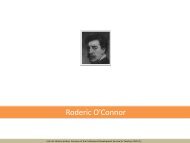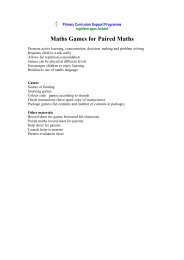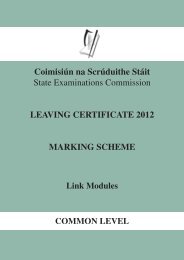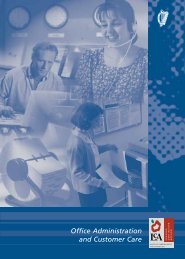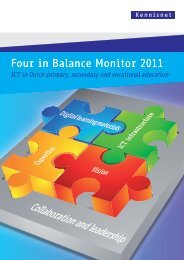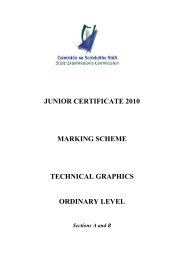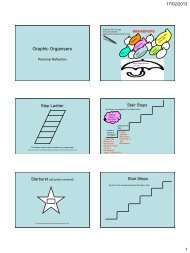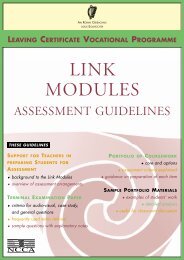Notes on Revised Junior Certificate Science Syllabus (PDF Format ...
Notes on Revised Junior Certificate Science Syllabus (PDF Format ...
Notes on Revised Junior Certificate Science Syllabus (PDF Format ...
Create successful ePaper yourself
Turn your PDF publications into a flip-book with our unique Google optimized e-Paper software.
<str<strong>on</strong>g>Notes</str<strong>on</strong>g> <strong>on</strong> the revised syllabus<br />
AN ROINN OIDEACHAIS AGUS EOLAÍOCHTA<br />
JUNIOR CERTIFICATE<br />
SCIENCE<br />
SYLLABUS<br />
(ORDINARY LEVEL AND HIGHER LEVEL)<br />
May 2003<br />
1
<strong>Junior</strong> <strong>Certificate</strong> <strong>Science</strong> – <strong>Revised</strong> <strong>Syllabus</strong><br />
<strong>Junior</strong> <strong>Certificate</strong> <strong>Science</strong><br />
<strong>Revised</strong> <strong>Syllabus</strong><br />
A revised syllabus for <strong>Junior</strong> <strong>Certificate</strong> <strong>Science</strong> has been prepared by the NCCA and has been<br />
approved by the Department of Educati<strong>on</strong> and <strong>Science</strong>. While most of the c<strong>on</strong>tent of the<br />
syllabus will be familiar to science teachers, this syllabus differs from that introduced in 1989 in<br />
a number of respects.<br />
• The most significant change is an increased emphasis <strong>on</strong> scientific investigati<strong>on</strong> and <strong>on</strong> the<br />
applicati<strong>on</strong> of science process skills in student activities.<br />
• The overall length of the syllabus has been significantly reduced to allow for student<br />
engagement in learning activities that will enable them to gain a better understanding of<br />
the science c<strong>on</strong>cepts involved and to develop their science process skills.<br />
• The structure of the syllabus has been simplified. Topics are presented under three main<br />
headings—biology, chemistry and physics—each of which is sub-divided into three secti<strong>on</strong>s.<br />
• Within each syllabus secti<strong>on</strong>, topics and sub-topics are described, together with associated<br />
learning outcomes. The learning outcomes embody the investigative approach emphasised<br />
in the revised syllabus and form the basis of the assessment arrangements.<br />
In the following pages, an overview is presented of the structure of the revised syllabus; the<br />
structure of the 1989 syllabus is included to facilitate comparis<strong>on</strong>. Details are also given of the<br />
changes in syllabus c<strong>on</strong>tent; topics that are new and syllabus c<strong>on</strong>tent that has been deleted are<br />
listed in separate tables. An exemplar is provided to illustrate the changed approach in the<br />
teaching and learning of science that is emphasised by the revised syllabus. Finally, an outline is<br />
given of the assessment comp<strong>on</strong>ents that apply to the revised syllabus.<br />
<strong>Junior</strong> <strong>Certificate</strong> <strong>Science</strong> – revised syllabus<br />
1. Biology 1A Human Biology – food, digesti<strong>on</strong> and associated body systems<br />
1B Human Biology – the skeletal/muscular system, the senses and<br />
human reproducti<strong>on</strong><br />
1C Animals, plants and micro-organisms<br />
2. Chemistry 2A Classificati<strong>on</strong> of substances<br />
2B Air, oxygen, carb<strong>on</strong> dioxide and water<br />
2C Atomic structure, reacti<strong>on</strong>s and compounds<br />
3. Physics 3A Force and energy<br />
3B Heat, light and sound<br />
3C Magnetism, electricity and electr<strong>on</strong>ics<br />
2
<strong>Junior</strong> <strong>Certificate</strong> <strong>Science</strong> – <strong>Revised</strong> <strong>Syllabus</strong><br />
<strong>Junior</strong> <strong>Certificate</strong> <strong>Science</strong> – 1989 syllabus<br />
All students 1. Core<br />
must study<br />
the core<br />
Introducti<strong>on</strong> to science<br />
The human body<br />
The n<strong>on</strong>-living envir<strong>on</strong>ment<br />
The living envir<strong>on</strong>ment<br />
Energy<br />
There are five extensi<strong>on</strong>s. At Ordinary level, students will select any three extensi<strong>on</strong>s.<br />
At Higher level, students will take the Physics, Chemistry and Biology extensi<strong>on</strong>s and will<br />
select either the Applied <strong>Science</strong> or the Local Studies extensi<strong>on</strong>.<br />
Physics 2. Forces and moti<strong>on</strong><br />
3. Heat<br />
4. Electricity and magnetism<br />
5. Light and sound<br />
Chemistry 6. Matter, the atom and elements<br />
7. Acids, bases and water<br />
8. Metals and electrochemistry<br />
Biology 9. Animal biology<br />
10. Plant biology<br />
11. Ecology<br />
Applied<br />
<strong>Science</strong><br />
Students<br />
taking this<br />
extensi<strong>on</strong><br />
will select<br />
any two of<br />
the six units<br />
12. Earth science<br />
13. Horticulture<br />
14. Materials science<br />
15. Food<br />
16. Electr<strong>on</strong>ics<br />
17. Energy c<strong>on</strong>versi<strong>on</strong>s<br />
Local Studies<br />
3
<strong>Junior</strong> <strong>Certificate</strong> <strong>Science</strong> – <strong>Revised</strong> <strong>Syllabus</strong><br />
Changes in c<strong>on</strong>tent<br />
The following tables give a summary of the changes in c<strong>on</strong>tent in the revised syllabus.<br />
The reference codes used in the table of new c<strong>on</strong>tent relate to the learning outcomes in the<br />
revised syllabus. The reference codes used in the table of deleted c<strong>on</strong>tent relate to the numbered<br />
secti<strong>on</strong>s and sub-secti<strong>on</strong>s used in the 1989 syllabus.<br />
The applied science extensi<strong>on</strong>s in the 1989 syllabus have not been retained, but some topics from<br />
these extensi<strong>on</strong>s have been included in the broad areas of biology, chemistry and physics, in the<br />
revised syllabus.<br />
For many topics there has been a change in emphasis and approach. An example of this is given<br />
<strong>on</strong> page 6.<br />
In additi<strong>on</strong> to the changes outlined in this document, there have been some changes to the<br />
level – Higher or Ordinary – at which certain topics will be assessed. Details of syllabus c<strong>on</strong>tent<br />
appropriate to each level can be found in the syllabus document – Higher level material is<br />
underlined. More detailed treatment of the changes will be provided in the Guidelines for Teachers.<br />
New c<strong>on</strong>tent<br />
Secti<strong>on</strong> Topic Ref.<br />
Biology major b<strong>on</strong>es in human body OB25<br />
growth and puberty<br />
OB33<br />
chromosomes are made of DNA and protein<br />
OB37<br />
simple key to identify plants and animals including<br />
vertebrates and invertebrates<br />
OB38<br />
functi<strong>on</strong> and main parts of a microscope<br />
OB42<br />
seed structure<br />
OB56<br />
Chemistry paper chromatography OC2<br />
solubility of a variety of substances in water; effect of<br />
temperature <strong>on</strong> solubility<br />
OC15<br />
qualitative test for dissolved solids<br />
OC30<br />
isotopes<br />
OC39<br />
Physics relati<strong>on</strong>ship between the extensi<strong>on</strong> and applied force<br />
for a spring<br />
OP6<br />
cooling curve<br />
luminous and n<strong>on</strong>-luminous objects<br />
sound detecti<strong>on</strong> in the ear<br />
OP29<br />
OP35<br />
OP42<br />
C<strong>on</strong>tent retained from extensi<strong>on</strong>s<br />
Secti<strong>on</strong> Topic Ref.<br />
Biology food tests OB3<br />
two uses of biotechnology in industry and in medicine OB66<br />
Chemistry natural gas OC57<br />
plastics: applicati<strong>on</strong>s, raw materials, c<strong>on</strong>tributi<strong>on</strong> to polluti<strong>on</strong> OC58/59/60<br />
Physics diodes OP57/60<br />
electr<strong>on</strong>ic circuits using switches, buzzers, LEDs and resistors OP58<br />
light-dependent resistor (LDR)<br />
OP59/60<br />
4
<strong>Junior</strong> <strong>Certificate</strong> <strong>Science</strong> – <strong>Revised</strong> <strong>Syllabus</strong><br />
Deleted c<strong>on</strong>tent<br />
Secti<strong>on</strong> Topic Ref.<br />
Biology tooth decay 9.3<br />
alternative systems of gaseous exchange 9.6<br />
endocrine system 9.10<br />
inheritance of a simple character 9.12<br />
three examples each of comm<strong>on</strong> local woody and<br />
n<strong>on</strong>-woody plants 10.2<br />
cambium 10.6<br />
mineral nutriti<strong>on</strong> in plants 10.7<br />
factors affecting transpirati<strong>on</strong> 10.8<br />
trophic levels 11.7<br />
soil study (except for investigati<strong>on</strong> of soil micro-organisms) 11.8<br />
Chemistry separati<strong>on</strong> of immiscible liquids 6.5<br />
different types of fire extinguisher 6.6<br />
surface tensi<strong>on</strong>, capillarity 6.6<br />
crystal structure 6.12<br />
oxidati<strong>on</strong> and reducti<strong>on</strong> 6.13<br />
heat changes in chemical reacti<strong>on</strong>s 6.14<br />
reacti<strong>on</strong>s of sulfuric acid 7.3<br />
distincti<strong>on</strong> between temporary hardness and<br />
permanent hardness 7.7<br />
relative corrodibility of metals 8.3<br />
electrochemistry (except for electrolysis of water) 8.4/6/7<br />
acidic and basic oxides 8.5<br />
Physics acti<strong>on</strong>-reacti<strong>on</strong> 2.8<br />
momentum 2.8<br />
definiti<strong>on</strong> of moment of force 2.11<br />
barometers - mercury and aneroid 2.16<br />
thermometers - mercury and alcohol 3.6<br />
sublimati<strong>on</strong> 3.7<br />
effect of pressure <strong>on</strong> melting point 3.7<br />
rates of c<strong>on</strong>ducti<strong>on</strong> of heat in metals 3.8<br />
tog values 3.8<br />
domestic ring circuits and spurs 4.9<br />
calculati<strong>on</strong>s <strong>on</strong> resistances in series 4.9<br />
waves 5.3<br />
electromagnetic spectrum 5.4<br />
eclipses, lenses, mixing of colours 5.5<br />
locati<strong>on</strong> of the earth within the solar system 12.1<br />
5
<strong>Junior</strong> <strong>Certificate</strong> <strong>Science</strong> – <strong>Revised</strong> <strong>Syllabus</strong><br />
Example of change of treatment<br />
1989 syllabus – Ref. 8.5 <strong>Revised</strong> syllabus – OC52<br />
Activity series: List of metals in order<br />
Investigate the relative reactivities of<br />
of reactivity<br />
Ca, Mg, Zn and Cu based <strong>on</strong> their<br />
K, Na, Ca, Mg, Zn, Fe, Cu, Ag reacti<strong>on</strong>s with water and acid<br />
In changing the emphasis from knowledge of a learned list to discovery through investigati<strong>on</strong>,<br />
many of the objectives of the revised syllabus (cf. pages 4 and 5) are achieved.<br />
The scientific method and the c<strong>on</strong>cept of a valid experiment<br />
Students will need to plan how they intend to observe the reacti<strong>on</strong>s of the metals with water<br />
and acid. In c<strong>on</strong>sidering the c<strong>on</strong>cept of a fair test, students might take into account factors such<br />
as particle size, temperature, and c<strong>on</strong>centrati<strong>on</strong> of acid to ensure that c<strong>on</strong>diti<strong>on</strong>s are the same<br />
for each metal.<br />
Observati<strong>on</strong>, measurement and the accurate recording of data<br />
Students need to observe the reacti<strong>on</strong>s carefully and record their observati<strong>on</strong>s accurately. They<br />
may devise some form of coding for these observati<strong>on</strong>s, for example, quantity of gas produced<br />
or amount of fizzing, and record these in graphic or tabular form.<br />
Logical thinking, inductive and deductive reas<strong>on</strong>ing<br />
Students might try the reacti<strong>on</strong> with water first and record their observati<strong>on</strong>s. They could then<br />
reas<strong>on</strong> that the metals that did not react with water should be tried with acid.<br />
<strong>Format</strong>i<strong>on</strong> of opini<strong>on</strong>s and judgements based <strong>on</strong> evidence and experiment<br />
Based <strong>on</strong> prior learning (OC51: reacti<strong>on</strong> between Zn and HCl) and experimental evidence<br />
students will deduce the order of reactivity.<br />
6
<strong>Junior</strong> <strong>Certificate</strong> <strong>Science</strong> – <strong>Revised</strong> <strong>Syllabus</strong><br />
Assessment of <strong>Junior</strong> <strong>Certificate</strong> <strong>Science</strong><br />
The revised syllabus for <strong>Junior</strong> <strong>Certificate</strong> <strong>Science</strong> will be assessed, at both Ordinary level and<br />
Higher level, by means of a terminal examinati<strong>on</strong> paper and coursework. The examinati<strong>on</strong><br />
paper will be allocated 65% of the total examinati<strong>on</strong> marks. There will be two comp<strong>on</strong>ents in<br />
the coursework assessment: Coursework A, accounting for 10% and Coursework B, accounting<br />
for 25%.<br />
The examinati<strong>on</strong> paper will c<strong>on</strong>sist of three secti<strong>on</strong>s – biology, chemistry and physics –<br />
reflecting the structure of the revised syllabus. Candidates will be required to answer questi<strong>on</strong>s<br />
in all three secti<strong>on</strong>s. There will be separate papers for Higher level and Ordinary level.<br />
Coursework A comprises the carrying out and recording of the thirty mandatory student<br />
activities identified in the syllabus. These activities are printed in bold type in the syllabus<br />
document. It is envisaged that, <strong>on</strong> completi<strong>on</strong> of the course, students will be required to<br />
provide evidence of this coursework, which will be retained in the school for the durati<strong>on</strong> of<br />
the assessment exercise. The State Examinati<strong>on</strong>s Commissi<strong>on</strong> will specify the requirements for<br />
the allocati<strong>on</strong> of the marks (10%) to this comp<strong>on</strong>ent.<br />
Coursework B involves the students in carrying out investigative work based <strong>on</strong> the syllabus<br />
topics and learning outcomes. Candidates will be required to submit a report of this work in a<br />
pro forma booklet. This investigative work may take the form of two separate investigati<strong>on</strong>s<br />
selected from three to be nominated each year by the State Examinati<strong>on</strong>s Commissi<strong>on</strong> (<strong>on</strong>e<br />
each in biology, chemistry and physics), or a single science investigati<strong>on</strong> of the student’s own<br />
choosing, which meets specified criteria.<br />
7
<strong>Junior</strong> <strong>Certificate</strong> <strong>Science</strong> – <strong>Revised</strong> <strong>Syllabus</strong><br />
NCCA and syllabus development<br />
Under the terms of the Educati<strong>on</strong> Act (1998), the Nati<strong>on</strong>al Council for Curriculum and<br />
Assessment (NCCA) advises the Minister for Educati<strong>on</strong> and <strong>Science</strong> <strong>on</strong> matters relating to<br />
(a)<br />
(b)<br />
the curriculum for early childhood educati<strong>on</strong>, primary and post-primary schools, and<br />
the assessment procedures employed in schools and examinati<strong>on</strong>s <strong>on</strong> subjects which<br />
are part of the curriculum.<br />
Subject syllabuses are prepared by NCCA course committees and are submitted to the Council<br />
of the NCCA for approval. The NCCA, having c<strong>on</strong>sidered the recommendati<strong>on</strong>s of the course<br />
committee, advises the Minister accordingly.<br />
The revised <strong>Junior</strong> <strong>Certificate</strong> <strong>Science</strong> syllabus was prepared by a course committee comprising<br />
representatives from:<br />
• Associati<strong>on</strong> of Sec<strong>on</strong>dary Teachers, Ireland<br />
• Teachers’ Uni<strong>on</strong> of Ireland<br />
• Joint Managerial Body<br />
• Associati<strong>on</strong> of Community and Comprehensive Schools<br />
• Irish Vocati<strong>on</strong>al Educati<strong>on</strong> Associati<strong>on</strong><br />
• Irish <strong>Science</strong> Teachers’ Associati<strong>on</strong><br />
• Department of Educati<strong>on</strong> and <strong>Science</strong> (Inspectorate)<br />
Further informati<strong>on</strong> may be obtained by c<strong>on</strong>tacting the NCCA at<br />
24 Merri<strong>on</strong> Square, Dublin 2.<br />
Tel: 01 661 7177 Fax: 01 661 7180<br />
Email: info@ncca.ie Website: www.ncca.ie<br />
8



